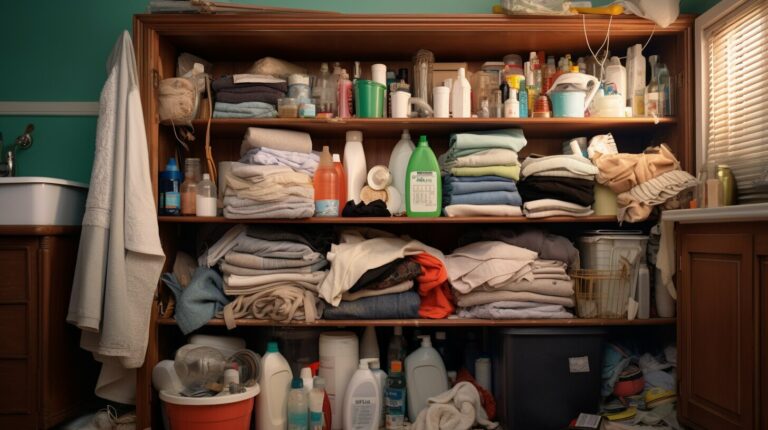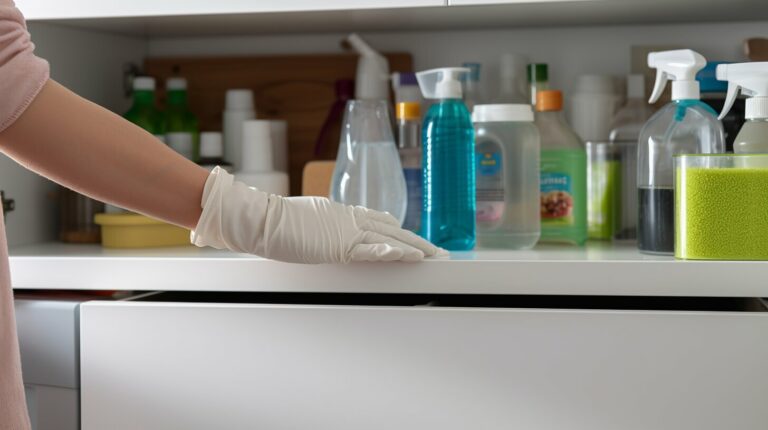Is your child’s room cluttered and challenging to keep organized? You’re not alone. Children’s rooms can quickly become messy and disorganized, making it challenging to find what you need and creating stress. Fortunately, with a little creativity, you can create a simplified and tidy space that promotes calm and creativity for your child.
In this section, we will explore ten DIY techniques for decluttering and organizing your child’s room. From purging toys to creating storage solutions, we’ll cover it all. Get ready to transform your child’s room into an organized and functional space.
Key Takeaways:
- DIY decluttering techniques can help you organize your child’s room.
- Space-saving hacks can help maximize storage in a small space.
- Creating an organizational plan is essential before diving into the decluttering process.
- Sorting and purging toys can help create a clutter-free playroom.
- Streamlining clothing storage can help free up space in your child’s room.
- Creative storage solutions can make keeping your child’s room organized more manageable.
- Maintenance is key to maintaining a clutter-free and functional child’s room.
Creating an Organizational Plan
Before diving into the decluttering process, it’s important to have a solid organizational plan in place. To start, take inventory of all the items in your child’s room, including toys, clothes, books, and games. Determine what items are essential and what items can be donated or thrown away. Once you’ve sorted through everything, it’s time to create a plan of action for organizing and storing the remaining items.
When creating your plan, think about the best ways to maximize space in your child’s room. Consider DIY storage solutions such as shelves, cubbies, and hanging organizers. You can also repurpose household items such as baskets and crates to create unique storage solutions.
To keep the room tidy and organized, consider implementing a rotation system for toys and books. This can be a great way to keep things fresh and exciting for your child while also keeping clutter to a minimum.
Throughout the entire process, involve your child and make it a fun activity. Set aside dedicated time each week for tidying up and maintaining the organization of the room. With a little effort and creativity, you can transform your child’s room into a clutter-free and functional space.
Sorting and Purging Toys
One of the biggest sources of clutter in a child’s room is toys. Sorting and purging toys is an essential part of decluttering and organizing the room. Here are some playroom solutions you can try:
- Categorize toys: Sort toys into categories such as building blocks, dolls, cars, and puzzles. This will make it easier to find specific toys and keep them organized.
- Involve your child: Let your child help you decide which toys to keep, donate, or toss. This can be an opportunity for your child to learn about giving to others and taking responsibility for their belongings.
- Donate or toss: Toys that your child has outgrown or no longer plays with can be donated to a local charity or sold in a yard sale. Broken or worn-out toys should be thrown away.
Effective cleaning is also important in maintaining an organized and clutter-free playroom. Here are some tips:
- Use washable bins and containers: Store toys in washable containers so you can easily clean them when needed.
- Establish a cleaning routine: Encourage your child to participate in cleaning up the playroom regularly. This can be a fun activity if you make it a game or play music while you clean.
- Rotate toys: Keep some toys in storage and rotate them every few months. This reduces clutter and makes it more exciting for your child to rediscover old toys.
Streamlining Clothing Storage
Clothes are often one of the biggest contributors to clutter in a kid’s room. This is especially true as your child grows and their clothing needs change frequently. Fortunately, there are many simple declutter methods you can use to streamline clothing storage and keep things organized:
- Maximize closet space: Closet space is often under-utilized in a child’s room. Consider adding an extra hanging rod to the closet or installing shelves to create more space.
- Use space-saving hangers: Using slim hangers or hangers with cascading hooks can save a lot of space in your child’s closet.
- Implement a rotation system: To avoid overwhelming your child with too many clothing options, consider implementing a rotation system. This means putting away clothing that is out of season or that your child has outgrown, and only keeping current options in their closet or dresser.
- Keep clothing accessible: Make sure that your child’s clothing is easy for them to access. This can mean using lower shelves or drawers for frequently-worn items, or hanging clothes at their eye level.
By using these simple strategies, you can create a streamlined and organized clothing storage system that will make getting dressed in the morning a breeze for both you and your child.
Creative Storage Solutions
Finding creative storage solutions is essential for maintaining an organized and clutter-free kid’s room. Here are some DIY storage ideas that can maximize space and keep toys, books, and other items neatly organized.
1. Utilize Vertical Space
Maximize storage space by using wall shelves or hanging baskets to store books, toys, and stuffed animals. Install pegboards on the walls to hang art supplies, backpacks, and hats to keep them off the floor. You can also use over-the-door organizers to store shoes or hair accessories.
2. Repurpose Household Items
Get creative with everyday household items that can be repurposed for storage. Use a shower caddy to store bath toys or hang a fruit basket to hold soft toys. Hang a curtain rod above a window to store stuffed animals or attach a magazine rack to the side of a dresser to store small books.
3. Build Custom Storage Units
If you have some DIY skills, build custom storage units that are tailored to your child’s needs. Use PVC pipes to create a hanging toy bin or build a bookshelf with crates or wooden boxes. You can also customize a desk with shelves or drawers to store school supplies and craft materials.
4. Use Bed Storage
Maximize space under the bed by using storage containers or baskets to store extra clothes, bedding, or toys. You can also purchase a bed frame with built-in drawers or use bed risers to create more storage space.
5. Implement a Rotation System
If your child has too many toys to keep out at once, implement a toy rotation system. Store some toys in containers and rotate them out every few weeks. This will not only keep the room tidy but also prevent your child from getting bored with their toys.
6. Store Items in Clear Containers
Store items in clear containers or bags, so your child can easily see what’s inside. This will help them find what they need and prevent them from making a mess while looking for something. You can also label the containers to make finding things even easier.
With these DIY storage ideas, you can maximize space and keep your child’s room organized and clutter-free. From utilizing vertical space to building custom storage units, there are endless possibilities for creating an efficient storage system that suits your child’s needs.
Maintenance and Continued Organization
Congratulations on successfully decluttering and organizing your child’s room! However, the work doesn’t stop there – maintenance and continued organization are key to keeping the space tidy.
To make tidying up a part of your child’s routine, set aside time each day to put away toys and clothes. Create designated spaces for items, so your child knows where everything belongs.
You can involve your child in the maintenance process by making it a fun game or challenge. For example, you could set a timer for five minutes and see how many toys your child can put away in that time.
As your child grows, their needs and interests will change. Be open to reassessing the organization and making adjustments as necessary.
Remember, home projects don’t have to be intimidating or overwhelming. With a bit of creativity and effort, maintaining a clutter-free kid’s room can be a breeze!
Conclusion
Decluttering your child’s room can be a challenge, but with these DIY techniques, you can transform it into a functional and organized space. By creating an organizational plan and implementing space-saving hacks, you can streamline clothing storage, sort and purge toys, and find creative storage solutions.
Remember, maintaining a clutter-free room requires ongoing effort and a willingness to adapt as your child grows. Make tidying up a fun and ongoing home project by involving your child in the process.
With these tips and tricks, you can create a simplified and efficient space that promotes a sense of calm and creativity for your child. Start your decluttering journey today and enjoy a more organized home!
FAQ
Q: How long does it take to declutter a kid’s room using these DIY techniques?
A: The time it takes to declutter a kid’s room will vary depending on the size of the room and the amount of clutter. It could take anywhere from a few hours to a few days to complete the process. Take your time and work at a pace that is comfortable for you.
Q: Can I involve my child in the decluttering process?
A: Absolutely! In fact, involving your child in the decluttering process can teach them valuable organizational skills and make them feel more connected to their space. Encourage them to make decisions about what to keep and what to donate or discard.
Q: Are there any specific storage solutions recommended for small kid’s rooms?
A: Yes, there are several storage solutions that work well in small kid’s rooms. Consider using under-bed storage containers, hanging organizers, or wall-mounted shelves to maximize space. You can also utilize multi-purpose furniture, such as beds with built-in storage drawers or bookshelves.
Q: How often should I reassess and declutter my child’s room?
A: It’s a good idea to reassess and declutter your child’s room at least twice a year. This will help keep the space organized and prevent clutter from accumulating. You may also want to do a quick decluttering session after birthdays or holidays when new toys and items are introduced.
Q: Can I repurpose household items for storage in my child’s room?
A: Absolutely! Repurposing household items for storage is a great way to save money and get creative with organization. For example, you can use shoe organizers to hold small toys, mason jars for art supplies, or hanging fruit baskets for stuffed animals.


